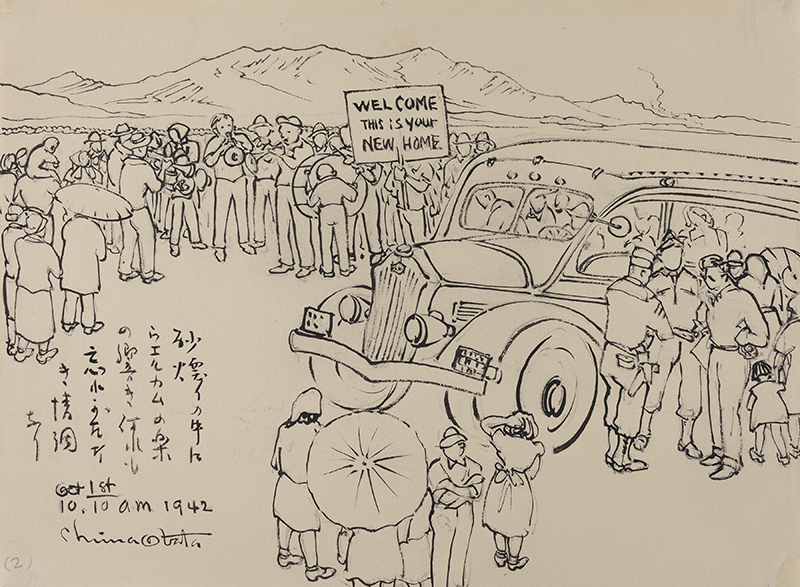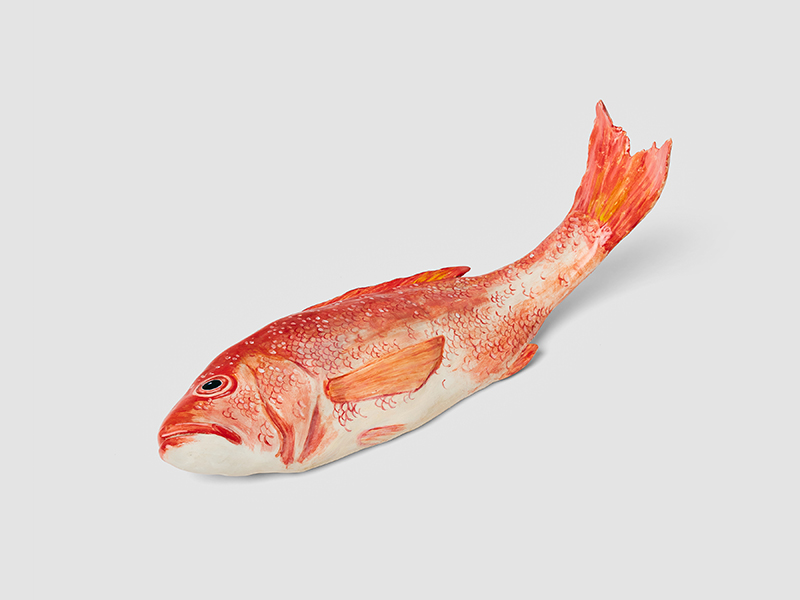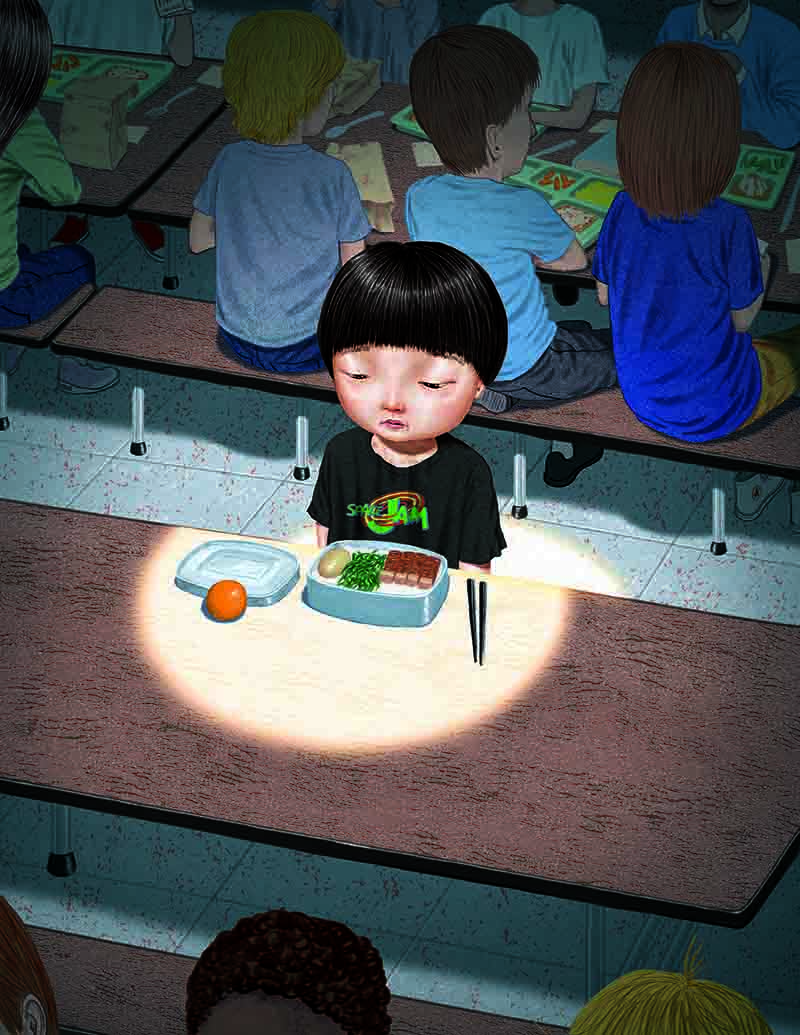"Without Apology: Asian American Selves, Memories, Futures" opens in December
By Bowdoin College Museum of Art
Arrivals welcomed at Topaz, Oct 1st, 10:10 a.m., 1942, 1942, ink and graphite on paper, by Chiura Obata, Japanese American, 1885–1975. From the Utah Museum of Fine Arts Permanent Collection, Gift of the Estate of Chiura Obata.
On December 14, the Museum will open Without Apology: Asian American Selves, Memories, Futures. This exhibition brings together the work of nineteen Asian American artists who share a common goal of reframing racial narratives of the past, examining the repercussions of historical legacies on present identities, and envisioning alternative paths for the future. Encompassing painting, sculpture, drawing, photography, illustration, printmaking, ceramics, and film, Without Apology includes works by established and emerging artists drawn from the Museum’s collection and through loans of generous lenders across the United States. Collectively, these artworks highlight the vibrancy and diversity of Asian American artistic expression over the past century.
Without Apology is organized into three sections. In the first, Memories, works by artists such as Tomie Arai, Hung Liu, Tuan Nguyen, Chiura Obata, and Kazumi Tanaka document and respond to historical currents that continue to reverberate through Asian American experiences today. Obata’s ink and graphite drawings stand out as much for the beauty of their lines as for the specific memories they evoke: his time in the concentration camps for Japanese American citizens during World War II. His Arrivals welcomed at Topaz [War Relocation Center], Oct 1st, 10:10 a.m., 1942 (1942) captures a memory of this experience, showing people milling around as someone holds a sign reading “Welcome This Is Your New Home.” On loan from the Utah Museum of Fine Art, this drawing also reflects Obata’s training in landscape painting—a connection that becomes even more apparent when juxtaposed with Thundering Nevada Falls (1955), an idyllic scene from Yosemite National Park that Obata created after his incarceration.
 The Regenerations section underscores the myriad ways Asian American artists have sought to reconstruct the past and forge new narratives in the present, and features works by Mel Chin, Yasuhiro Ishimoto, An-my Lê, Alfonso Ossorio, Stephanie H. Shih, Shahzia Sikander, and Reuben Tam. For example, Shih reclaims food items that are stereotypically associated with Asian Americans and transforms them into proud emblems of a remarkable culinary tradition. Her painted ceramic works of branded products like Gold Plum Chinkiang Vinegar (2022) and Yang Jiang Preserved Beans (2022), as well as East Asian food staples such as Bok Choy (2022) and Red Snapper (2023), recognize food as a form of cultural expression deeply rooted in personal, familial, and global histories. With these sculptures, recent additions to the Museum’s collection, Shih shares the intimacy and immediacy of the diasporic home kitchen with audiences.
The Regenerations section underscores the myriad ways Asian American artists have sought to reconstruct the past and forge new narratives in the present, and features works by Mel Chin, Yasuhiro Ishimoto, An-my Lê, Alfonso Ossorio, Stephanie H. Shih, Shahzia Sikander, and Reuben Tam. For example, Shih reclaims food items that are stereotypically associated with Asian Americans and transforms them into proud emblems of a remarkable culinary tradition. Her painted ceramic works of branded products like Gold Plum Chinkiang Vinegar (2022) and Yang Jiang Preserved Beans (2022), as well as East Asian food staples such as Bok Choy (2022) and Red Snapper (2023), recognize food as a form of cultural expression deeply rooted in personal, familial, and global histories. With these sculptures, recent additions to the Museum’s collection, Shih shares the intimacy and immediacy of the diasporic home kitchen with audiences.
Portraits by Susan Chen, Mel Chin, Patrick Nagatani, Laurel Nakadate, Jason Raish, Roger Shimomura, and Stephanie Syjuco are at the heart of the Selves section, providing insight into how Asian Americans assert their identities in bold, playful, and often unexpected ways. Responding directly to the rise of anti-Asian discrimination and violence during the COVID-19 pandemic, Chen’s 2021 painting I Am Not the Kung Flu is a self-portrait of the artist surrounded by the tools for self-protection that an Asian American might need, from a face mask and vaccination to a whistle and pepper spray. The allusion to a Zoom screen, indicated by details at the bottom edge of the self-portrait, also attest to alternative forms of community and solidarity that Chen—and many others—found during the pandemic.  Another work in this section is Raish’s 2023 digital illustration Asian American Identity, which depicts a young, Asian American child eating lunch alone in a school cafeteria. Bathed in a spotlight, the viewer’s eye drawn to the boy’s dejected expression, bento box, and chopsticks, while other children at the table behind eat from the school’s cafeteria trays. The child’s sense of loneliness and isolation is intense and visceral, signaling the exclusion and scrutiny Asian Americans face even at a young age.
Another work in this section is Raish’s 2023 digital illustration Asian American Identity, which depicts a young, Asian American child eating lunch alone in a school cafeteria. Bathed in a spotlight, the viewer’s eye drawn to the boy’s dejected expression, bento box, and chopsticks, while other children at the table behind eat from the school’s cafeteria trays. The child’s sense of loneliness and isolation is intense and visceral, signaling the exclusion and scrutiny Asian Americans face even at a young age.
Organized as part of a broader, College-wide initiative on Asian American history, culture, and identity, Without Apology culminates a collaborative curatorial project with Bowdoin faculty members Connie Y. Chiang, Professor of History and Environmental Studies; Shruti Devgan, Assistant Professor of Sociology; Belinda Kong, Professor of Asian Studies and English; Nancy Riley, A. Myrick Freeman Professor of Social Sciences; and Shu-chin Tsui, Bowdoin Professor of Asian Studies and Cinema Studies. These faculty curators bring new forms of expertise and insight to bear on Asian American art and history from the disciplines of film and media studies, history, literary studies, and sociology, ensuring that the exhibition celebrates the creative vitality and resilience of Asian America as a community that perpetually envisions new forms of belonging.
Cassandra Braun
Curator, Bowdoin College Museum of Art
Illustrations:
Red Snapper, 2023, coil-built ceramic and paint, by Stephanie Shih, Taiwanese American, born 1986. Bowdoin College Museum of Art, Museum Purchase, Lloyd O. and Marjorie Strong Coulter Fund. 2023.25.4
Asian American Identity, 2016, originally published in Banana Magazine, Issue 003, digital illustration by Jason Raish, Korean American born 1981.